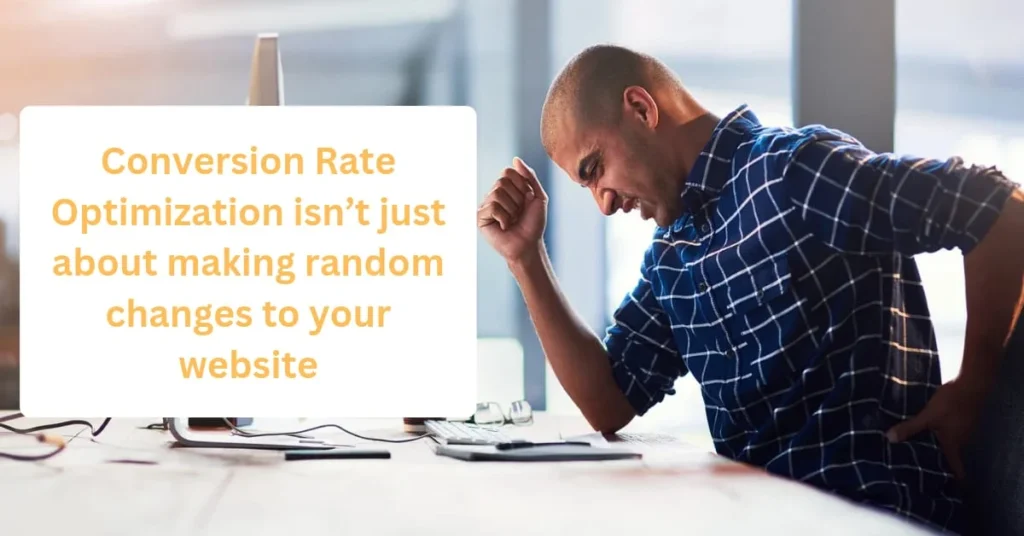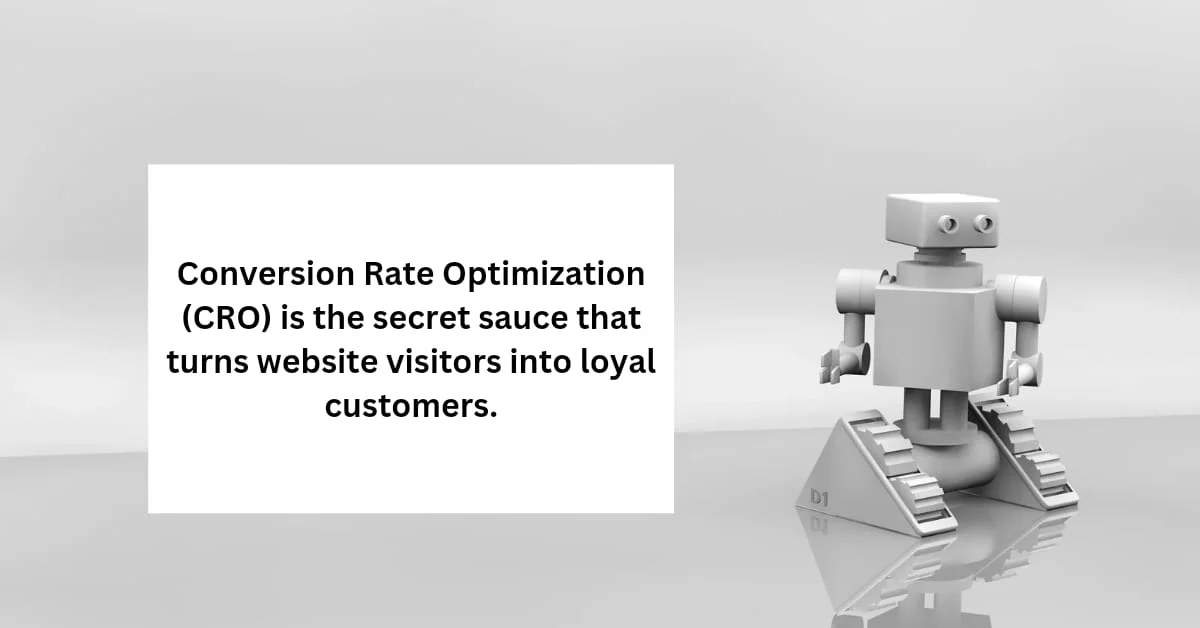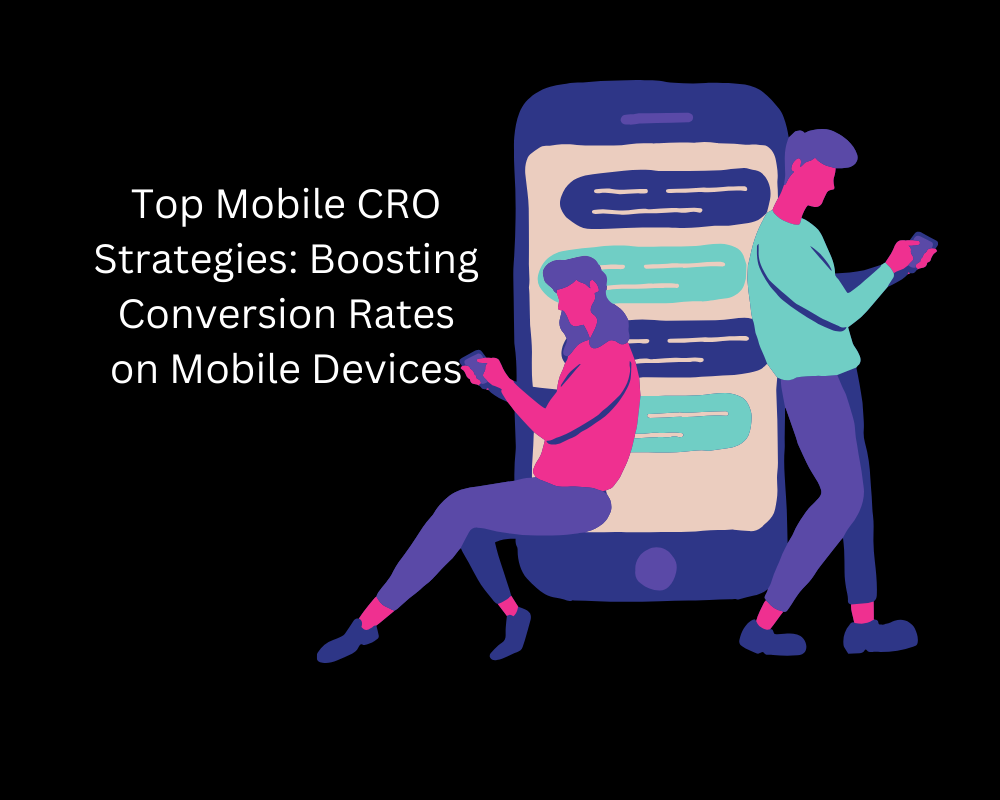Ever wondered why your website gets tons of traffic but not enough sales? You might be pulling in the numbers, but if visitors aren’t converting into customers, then it’s like having a bustling store with no buyers. This is where Conversion Rate Optimization, or CRO, comes into play.
Conversion Rate Optimization (CRO) is the secret sauce that turns website visitors into loyal customers. It’s about making the most of the traffic you already have by optimizing your site to nudge users toward taking action—whether that’s making a purchase, signing up for a newsletter, or filling out a form. In this post, we’ll dive into what CRO is, why it matters, and how you can start using it to boost your online success.
What Is Conversion Rate Optimization (CRO)?

At its core, Conversion Rate Optimization (CRO) is the process of enhancing your website or landing page to increase the percentage of visitors who complete a desired action. This action could be anything from buying a product to signing up for a newsletter or downloading a resource. Simply put, CRO is about making your website work smarter, not harder.
How CRO Works
CRO works by analyzing how users interact with your website and identifying barriers that prevent them from converting. It’s a mix of science and art—using data to guide decisions while creatively testing and tweaking elements like headlines, images, call-to-action buttons, and more.
Basic Formula
Understanding CRO starts with knowing how to calculate your conversion rate. Here’s the simple formula:
Conversion Rate=(ConversionsTotal Visitors)×100\text{Conversion Rate} = \left( \frac{\text{Conversions}}{\text{Total Visitors}} \right) \times 100Conversion Rate=(Total VisitorsConversions)×100
For example, if 1,000 people visit your site and 50 of them make a purchase, your conversion rate is 5%. The goal of CRO is to increase that percentage by making improvements based on user behavior and feedback.
Why CRO Matters
You might be wondering, “Why should I focus on CRO when I’m already getting decent traffic?” The answer lies in the power of converting that traffic into tangible results. Here’s why CRO is a game-changer for your online presence:

Importance of CRO
CRO is crucial because it directly impacts your bottom line. It’s about making the most of the visitors you already have, rather than spending more time and money to attract new ones. With CRO, even a small increase in conversion rate can lead to a significant boost in revenue. For example, if you improve your conversion rate from 2% to 4%, you’ve effectively doubled your sales without needing any additional traffic.
Impact on Business
CRO doesn’t just increase sales or leads—it also enhances overall business growth. Higher conversion rates mean more efficient use of your marketing budget and better ROI. This efficiency allows businesses to scale faster and more sustainably, as every marketing dollar spent becomes more valuable.
Relation to User Experience (UX)
One of the most compelling reasons to invest in CRO is its connection to user experience (UX). A well-optimized site not only converts better but also provides a smoother, more enjoyable experience for visitors. CRO often involves refining the user journey, removing obstacles, and making it easier for users to find what they need. As a result, happier users are more likely to convert, and satisfied customers are more likely to return.
Key Benefits of Conversion Rate Optimization (CRO)
Conversion Rate Optimization (CRO) offers numerous benefits that go beyond just improving your bottom line. When done right, CRO can transform your online presence and provide long-term value. Here are some of the key advantages:

Increased Revenue
The most obvious benefit of CRO is the potential for increased revenue. By improving your conversion rate, you can generate more sales or leads from the same amount of traffic. This means higher profits without the need for additional advertising or outreach efforts. Whether you’re an e-commerce store, a service provider, or a content creator, a better conversion rate directly translates to more money in your pocket.
Better Customer Insights
Conversion Rate Optimization (CRO) isn’t just about tweaking your website; it’s about understanding your customers on a deeper level. Through CRO, you gain valuable insights into user behavior, preferences, and pain points. Tools like heatmaps, user recordings, and A/B testing reveal what’s working and what’s not, allowing you to make data-driven decisions. These insights can help you fine-tune not just your website but also your overall marketing strategy.
Enhanced User Experience
A key aspect of CRO is improving the user experience (UX). When your website is optimized for conversions, it’s also optimized for ease of use. This means fewer frustrations, quicker load times, and a more intuitive navigation system. An enhanced user experience leads to higher satisfaction, which can increase customer loyalty and encourage repeat visits.
Competitive Edge
In today’s crowded online marketplace, standing out is crucial. CRO gives you a competitive edge by making your website more effective than those of your competitors. When your site converts better, you’re maximizing the value of every visitor, outpacing competitors who might be focusing solely on increasing traffic. This strategic advantage can help you dominate your niche.
Basic Elements and Techniques of CRO
Now that we’ve covered why CRO is essential, let’s dive into the nuts and bolts of how it works. Conversion Rate Optimization isn’t just about making random changes to your website; it involves a systematic approach to improve specific elements that influence user behavior. Here are some of the core components and techniques used in CRO:

Landing Page Optimization
Your landing page is often the first impression visitors get, so it needs to be spot-on. Key elements to focus on include:
- Headlines: Your headline should grab attention and clearly communicate the value proposition.
- Call-to-Action (CTA): The CTA is the most critical element on the page. It should be compelling, concise, and easy to find.
- Layout and Design: A clean, intuitive design helps guide the user’s eyes to the most important elements, such as the CTA.
- Social Proof: Testimonials, reviews, and trust badges can help build credibility and persuade visitors to convert.
A/B Testing
A/B testing is the cornerstone of CRO. This technique involves creating two versions of a webpage (Version A and Version B) and testing them against each other to see which one performs better. Here’s how it works:
- Test One Element at a Time: Focus on testing a single variable, such as the headline or CTA, to isolate its impact.
- Use Data to Guide Decisions: Rely on analytics to determine what to test, rather than making changes based on gut feelings.
- Continuous Testing: CRO is an ongoing process, and continuous testing helps ensure that your website is always optimized.
Heatmaps and Analytics
Understanding how users interact with your site is crucial for effective CRO. Tools like heatmaps and analytics provide insights into user behavior, such as where they click, how far they scroll, and which areas they ignore. These insights can help you:
- Identify Problem Areas: Spot sections of your site that may be causing users to drop off.
- Optimize Layout and Design: Make adjustments based on where users are focusing their attention.
- Improve Navigation: Streamline the user journey by removing obstacles and making it easier to find important information.
Copy and Design Tweaks
Even small changes in your website’s copy and design can have a big impact on conversion rates. Here are some areas to consider:
- Copywriting: Your copy should be clear, persuasive, and aligned with your audience’s needs. Highlight benefits, address pain points, and use a tone that resonates with your target audience.
- Visual Elements: Images, videos, and color schemes can all influence user behavior. Ensure that your visuals support your messaging and guide users toward your CTA.
Common CRO Tools and Resources
To successfully implement Conversion Rate Optimization (CRO), you need the right tools and resources. These tools can help you gather data, analyze user behavior, and test different elements on your website to find what works best. Here’s a look at some of the most popular CRO tools and resources available:

Overview of Popular Tools
- Google Optimize: This free tool from Google allows you to run A/B tests and multivariate tests on your website. It integrates seamlessly learn with Google Analytics, making it easy to analyze the results of your tests.
- Hotjar: Hotjar provides heatmaps, session recordings, and feedback tools that give you a deeper understanding of how users interact with your site. You can see exactly where users click, how far they scroll, and even collect feedback directly from them.
- Optimizely: Optimizely is a powerful platform for running A/B tests, multivariate tests, and personalization campaigns. It’s a bit more advanced and is particularly suited for larger businesses looking to take their CRO efforts to the next level.
- Crazy Egg: Crazy Egg offers heatmaps, scrollmaps, and A/B testing features. It’s user-friendly and particularly useful for visualizing how users navigate your site.
- VWO (Visual Website Optimizer): VWO is an all-in-one platform that offers A/B testing, multivariate testing, and split URL testing. It also includes behavioral insights like heatmaps and session recordings.
How to Choose the Right Tool
Selecting the right CRO tool depends on your specific needs, budget, and the complexity of your website. Here are a few factors to consider:
- Budget: Some tools, like Google Optimize, are free, while others, like Optimizely, can be more expensive. Determine what you’re willing to invest in CRO.
- Ease of Use: If you’re new to CRO, choose a tool with a user-friendly interface. Hotjar and Crazy Egg are great options for beginners.
- Features: Identify the features that are most important for your business. Do you need advanced testing capabilities, or are heatmaps and basic A/B testing enough?
- Integration: Ensure that the tool integrates with your existing analytics platform or CMS (Content Management System).
Additional Learning Resources
To deepen your understanding of CRO, consider exploring these resources:
- Blogs and Websites: Sites like ConversionXL, Neil Patel’s blog, and Optimizely’s blog offer valuable insights, tips, and case studies.
- Books: Books like “Don’t Make Me Think” by Steve Krug and “Landing Page Optimization” by Tim Ash are excellent for understanding the principles of CRO.
- Courses: Online platforms like Coursera, Udemy, and LinkedIn Learning offer courses on CRO that can help you build your skills.
Real-world Examples of Successful CRO
Learning about Conversion Rate Optimization (CRO) is one thing, but seeing it in action can really drive home its importance. Here are a couple of real-world examples that illustrate how effective CRO can be:

Case Study 1: Airbnb
Airbnb, the popular online marketplace for lodging, implemented a CRO strategy that focused on simplifying the booking process. They noticed that users were dropping off during the reservation stage, so they decided to A/B test different variations of the booking flow.
- What They Changed: Airbnb simplified the reservation form, reduced the number of steps required to book a room, and clarified pricing information upfront.
- The Result: These changes led to a significant increase in bookings. By streamlining the user experience, Airbnb improved their conversion rate and, ultimately, their revenue.
Case Study 2: ASOS
ASOS, a leading online fashion retailer, used CRO to optimize their checkout process. They identified that many users were abandoning their carts during the payment stage, so they focused on reducing friction in this area.
- What They Changed: ASOS introduced a guest checkout option, making it easier for users to complete their purchase without creating an account. They also improved the clarity of error messages during the checkout process.
- The Result: These changes led to a 50% reduction in cart abandonment and a notable increase in completed purchases.
Lessons Learned
These examples highlight a few key takeaways:
- Simplicity is Key: Simplifying the user experience, whether through a more straightforward booking process or a guest checkout option, can have a significant impact on conversion rates.
- User Feedback Matters: Understanding why users abandon your site or drop off at certain points is crucial. Use tools like surveys and session recordings to gather insights.
- Continuous Testing: CRO is not a one-time fix; it requires ongoing testing and refinement. What works today may need adjustments tomorrow as user behavior evolves.
The Role of A/B Testing in Conversion Rate Optimization (CRO)
A/B testing is one of the most powerful tools in your CRO arsenal. It allows you to test different versions of your website elements to see which one performs better in terms of conversions. By making data-driven decisions rather than relying on guesswork, A/B testing can lead to significant improvements in your conversion rate. Let’s take a closer look at how A/B testing works and why it’s so effective.

Explanation of A/B Testing
A/B testing, also known as split testing, involves comparing two versions of a webpage or specific elements on a page to determine which one performs better. Here’s how it typically works:
- Create Two Variations: Start by creating two versions of a webpage—Version A (the control) and Version B (the variant). The two versions should differ in only one element, such as the headline, CTA, or layout.
- Split Your Audience: Your website traffic is then split between these two versions. For instance, half of your visitors see Version A, and the other half see Version B.
- Analyze Results: After running the test for a sufficient period, analyze the results to see which version had a higher conversion rate. The winning version can then be implemented as the new standard.
Examples of A/B Tests
A/B testing can be applied to various elements on your site. Here are some common areas to test:
- Headlines: Test different headlines to see which one grabs more attention and leads to conversions.
- Call-to-Action (CTA) Buttons: Experiment with different wording, colors, and placements of your CTA buttons to find what works best.
- Images and Videos: Test the impact of using different visuals, such as changing a product image or adding a video.
- Forms: Optimize forms by testing the number of fields, the layout, or the inclusion of a progress bar.
- Page Layouts: Experiment with different page layouts to see how changes in the structure affect user behavior.
Best Practices for A/B Testing
To get the most out of your A/B tests, follow these best practices:
- Test One Variable at a Time: Focus on testing one element at a time to ensure you can attribute any changes in performance to that specific variable.
- Use a Large Enough Sample Size: Ensure your sample size is large enough to produce statistically significant results. Running tests on too small a sample can lead to inaccurate conclusions.
- Run Tests for an Appropriate Duration: Don’t end your test too early. Give it enough time to gather data and reach a reliable conclusion, usually at least one to two weeks.
- Iterate and Learn: A/B testing is an ongoing process. Use the insights from each test to inform future experiments, and continue refining your website for better performance.
How Conversion Rate Optimization (CRO) Aligns with Other Marketing Strategies
Conversion Rate Optimization (CRO) doesn’t operate in a vacuum—it works best when integrated with your broader marketing strategies. CRO can enhance the effectiveness of other efforts, like Search Engine Optimization (SEO), Pay-Per-Click (PPC) advertising, and content marketing. Let’s explore how CRO complements and amplifies these strategies.
SEO and CRO: A Perfect Pair
SEO is all about driving organic traffic to your website, while CRO focuses on converting that traffic into customers. When combined, these strategies can significantly improve your online performance. Here’s how they work together:
- User Experience: Both SEO and CRO prioritize a positive user experience. Fast load times, mobile-friendly design, and easy navigation improve SEO rankings and encourage conversions.
- Content Optimization: Optimized content that ranks well in search engines also needs to be persuasive and engaging to convert visitors. CRO techniques can refine your content to ensure it not only attracts clicks but also drives action.
- Reduced Bounce Rate: By optimizing pages for conversions, you reduce the bounce rate—a key SEO metric. When visitors find what they need and take action, they stay longer on your site, which can improve your search rankings.
PPC and CRO: Maximizing Ad Spend
PPC advertising can drive targeted traffic to your site, but without effective CRO, you might be wasting your ad budget. Here’s how CRO boosts your PPC campaigns:
- Landing Page Optimization: CRO ensures that the landing pages linked to your PPC ads are designed to convert. A well-optimized landing page can turn more clicks into conversions, increasing your return on ad spend (ROAS).
- Ad Copy and CRO: The messaging in your PPC ads should align with the landing page content. Consistency between the ad and the page helps meet user expectations and improve conversion rates.
- Quality Score Improvement: Google’s Quality Score considers the relevance of your landing page, which impacts your ad costs. CRO can improve the quality and relevance of your landing pages, leading to lower costs per click.
CRO as Part of a Holistic Strategy
CRO should be seen as a continuous process that’s integrated into every aspect of your marketing strategy. When aligned with your overall goals, CRO can:
- Support Content Marketing: Use CRO to identify which types of content resonate most with your audience. This insight can guide your content creation efforts, ensuring you produce material that not only attracts visitors but also converts them.
- Enhance Email Marketing: CRO can improve the effectiveness of email campaigns by optimizing landing pages and forms that your emails link to, ensuring that the leads generated are effectively nurtured into conversions.
- Drive Long-term Success: By aligning CRO with all marketing channels, you create a cohesive strategy where every effort supports the goal of driving conversions. This holistic approach leads to sustainable growth and higher ROI.
Potential Challenges and Pitfalls in CRO
While Conversion Rate Optimization (CRO) can be incredibly effective, it’s not without its challenges. Understanding the potential pitfalls can help you navigate the process more smoothly and avoid common mistakes. Here are some of the most frequent challenges you might encounter with CRO and how to overcome them:

Common Mistakes in Conversion Rate Optimization (CRO)
- Testing Too Many Variables at Once: It can be tempting to change multiple elements on a page simultaneously, but doing so makes it difficult to determine which change actually led to an improvement. Instead, focus on testing one variable at a time to get clear, actionable results.
- Insufficient Data: Running tests without enough traffic or for too short a period can lead to misleading conclusions. Ensure your sample size is large enough, and allow the test to run long enough to achieve statistically significant results.
- Ignoring Qualitative Data: While quantitative data is essential, don’t overlook the value of qualitative insights. User feedback, session recordings, and surveys can reveal issues that numbers alone might miss, such as confusion over site navigation or dissatisfaction with content.
- Overlooking the User Journey: Focusing solely on individual page optimizations without considering the entire user journey can limit the effectiveness of your CRO efforts. It’s important to understand how users move through your site and optimize the entire path to conversion, not just isolated pages.
Overcoming Challenges in Conversion Rate Optimization (CRO)
- Continuous Learning: CRO is an ongoing process, not a one-time task. Be prepared to continuously test, learn, and adapt your strategies as user behavior and market conditions change.
- Prioritization: With so many potential areas to optimize, it’s easy to get overwhelmed. Prioritize your efforts by focusing on high-impact areas first—those that are most critical to your business goals or that have the highest potential for improvement.
- Balancing User Experience with Conversion Goals: While the goal of CRO is to increase conversions, it’s crucial not to do so at the expense of the user experience. Ensure that any changes made to improve conversions also enhance—or at least maintain—the overall usability of your site.
- Maintaining Consistency Across Channels: Your CRO efforts should be consistent with the messaging and branding across all your marketing channels. Disjointed experiences can confuse users and reduce the effectiveness of your optimization efforts.
The Need for Continuous Improvement
Conversion Rate Optimization (CRO) is not a one-and-done deal; it requires ongoing attention. What works today may not work tomorrow as user preferences, technologies, and market conditions evolve. That’s why it’s crucial to approach CRO as a continuous improvement process. Regularly revisit your strategies, analyze new data, and stay flexible in adapting to new trends.
To Conclude
Conversion Rate Optimization (CRO) is more than just a buzzword—it’s a vital strategy for any business looking to maximize the effectiveness of its online presence. By understanding what CRO is and why it matters, you can begin to turn more of your website visitors into loyal customers, driving up your revenue and achieving your business goals.
From defining CRO and exploring its importance to diving into practical techniques and tools, we’ve covered a lot of ground in this guide. Whether you’re just starting out or looking to refine your existing strategies, remember that CRO is an ongoing process. It requires continuous testing, learning, and adapting to ensure your website not only attracts visitors but also converts them.
Final Thoughts
Don’t let high traffic go to waste. Start by applying some of the Conversion Rate Optimization (CRO) techniques we’ve discussed, and watch as your website begins to work harder for you. Small changes can lead to significant improvements, so don’t be afraid to experiment and see what works best for your audience.












